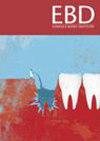软组织替代品改善患者报告的种植体周围软组织增强的结果。
Q3 Dentistry
引用次数: 0
摘要
数据来源:系统检索截至2021年11月22日的5个电子数据库(PubMed、Embase、Central、Web of Science和Epistemonikos)和灰色文献,以确定与种植体周围软组织增强术中患者报告的结果测量(PROMs)相关的研究。研究选择:两位作者根据预先确定的纳入标准,在删除重复文献后,独立审查文章的标题、摘要(筛选阶段)和全文(合格阶段)。共有29项临床研究(19项随机临床试验,7项非随机研究和3例病例系列)符合基于PICO框架的入选标准。数据提取和综合:由两位作者使用数据提取表从纳入的研究中独立提取数据。采用加权平均差(WMD)和95%置信区间(ci)对PROMs的平均值进行汇总分析,总结比较研究结果。采用随机效应模型进行了11个亚组荟萃分析(每个亚组包括2-6个研究),以确定自体软组织移植物和替代品之间PROMs(视觉模拟量表[VAS]疼痛评分、镇痛药消耗、VAS满意度、美感、手术持续时间和生活质量)平均值的差异。结果:对于粘膜厚度增加,与上皮下结缔组织移植物(SCTG)相比,软组织替代物在0-100时的疼痛感知显著降低(n = 4;WMD = 14.91 VAS单位;95% ci: 6.42-23.40;P结论:使用软组织代用品进行种植体周围软组织隆胸,在术后疼痛、镇痛摄入、手术时间等方面均有明显改善。与自体移植物相比,软组织替代物获得了相似的患者满意度和美感水平,而不影响临床结果。本文章由计算机程序翻译,如有差异,请以英文原文为准。

Soft tissue substitutes improve patient-reported outcomes in peri-implant soft tissue augmentation
Five electronic databases (PubMed, Embase, Central, Web of Science, and Epistemonikos) and grey literature were systematically searched up to November 22, 2021 to identify studies relevant to patient-reported outcome measures (PROMs) in peri-implant soft tissue augmentation. Two authors independently reviewed the title, abstrac (screening phase), and full text (eligibility phase) of the articles after removing the duplicates, based on the pre-established inclusion criteria. A total of 29 clinical studies (19 randomized clinical trials, 7 non-randomized studies, and 3 case series) fulfilled the eligibility criteria based on the PICO framework. Data were independently extracted from the included studies by two authors using data extraction tables. The mean values of PROMs were pooled and analyzed with the weighted mean difference (WMD) and 95% confidence intervals (CIs) to summarize and compare the studies. Eleven subgroup meta-analyses (including 2–6 studies in each) were conducted using random-effect models to determine the differences in mean values of PROMs (pain scores on the Visual Analog Scale [VAS], analgesic consumption, satisfaction on VAS, aesthetic perception, surgery duration, and quality of life) between soft tissue autografts and substitutes. For mucosal thickness gain, pain perception was significantly reduced with soft tissue substitutes compared to subepithelial connective tissue graft (SCTG) at both 0–100 (n = 4; WMD = 14.91 VAS units; 95% CI: 6.42–23.40; P < 0.0006) and 0–10 VAS scale (n = 4; WMD = 1.62 VAS units; 95% CI: 0.01–3.23; P = 0.05). Similar results of significantly reduced pain with soft tissue substitutes on a 0–100 (n = 2; WMD = 21.43 VAS units; 95% CI: 12.58–30.28; P < 0.0001) and 0–10 VAS scale (n = 4; WMD = 1.65 VAS units; 95% CI: 0.66–2.64; P = 0.001) were found for keratinized tissue gain. Furthermore, with soft tissue substitutes painkiller consumption (n = 6; WMD = 1.56 tablets; 95% CI: 1.22–1.91; P < 0.00001) and surgery time (n = 5; WMD = 10.9 min; 95% CI: 4.60–17.19; P < 0.00001) were significantly less in comparison to autogenous grafts. Patient satisfaction, aesthetic perception, and quality of life did not differ significantly between soft tissue substitutes and autogenous grafts for soft tissue augmentation around implants. PROMs in terms of postoperative pain, analgesic intake, and surgery duration are significantly improved with the use of soft tissue substitutes for peri-implant soft tissue augmentation. Similar levels of patient satisfaction and aesthetic perception were achieved with soft tissue substitutes as with autogenous grafts, without impairing the clinical outcomes.
求助全文
通过发布文献求助,成功后即可免费获取论文全文。
去求助
来源期刊

Evidence-based dentistry
Dentistry-Dentistry (all)
CiteScore
2.50
自引率
0.00%
发文量
77
期刊介绍:
Evidence-Based Dentistry delivers the best available evidence on the latest developments in oral health. We evaluate the evidence and provide guidance concerning the value of the author''s conclusions. We keep dentistry up to date with new approaches, exploring a wide range of the latest developments through an accessible expert commentary. Original papers and relevant publications are condensed into digestible summaries, drawing attention to the current methods and findings. We are a central resource for the most cutting edge and relevant issues concerning the evidence-based approach in dentistry today. Evidence-Based Dentistry is published by Springer Nature on behalf of the British Dental Association.
 求助内容:
求助内容: 应助结果提醒方式:
应助结果提醒方式:


